Guédé Chantier, Senegal
“In the 2000s, we felt our land was dying. We were not getting the yields we were expecting,” says Ousmane Pame, who grew up in Guédé Chantier, a village of 7,000 inhabitants in northern Senegal.
In the 1970s Chinese agricultural advisers came to the rice-growing area and taught new methods that involved a lot of chemical fertiliser.
But by 2002, the soil was seriously degraded and the villagers decided to take action. “The whole village got together for three days to reflect on the agriculture, the economy, the education, because we felt we were going through a crisis.”
Pame had been on an eco village design course in Auroville, India, and told the village chief and the whole community what he had learned; the decision was made to transition to an ecovillage, and Pame was later elected mayor.
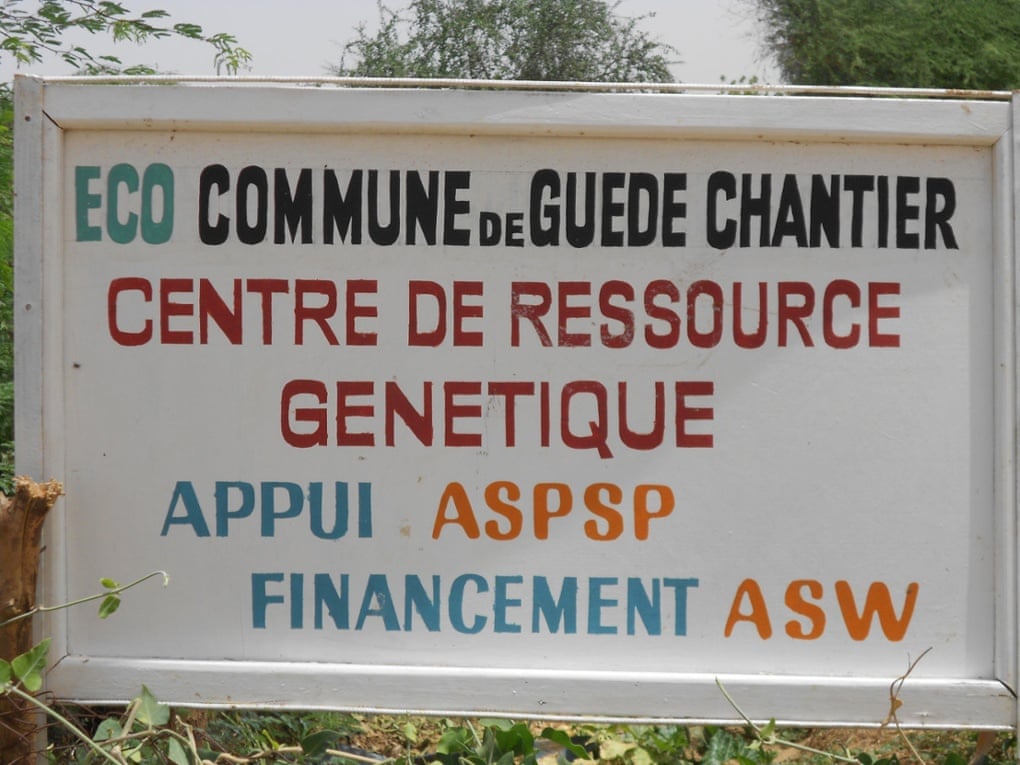 Guédé Chantier eco village, Senegal Photograph: Ousmane Pame
Guédé Chantier eco village, Senegal Photograph: Ousmane Pame
Now Guede alternates between rice and other crops (tomatoes, onions, corn, okra) and has set up community orchards. The village has also established a centre of genetic resources to provide seeds for local species, which are distributed for free to farmers. They also get lessons on composting, seed production and organic farming. The village’s “eco-guardians” organise regular public clean-ups and theatre is used to educate people about the dangers of litter and chemical inputs in the field.
The village is also moving to renewable energy, mainly biogas. “We have lots of animals so we can use cow manure to power the biogas,” says Pame.
The government has been very supportive of ecovillages in Senegal. It is working on a project to turn 14,000 traditional rural villages into renewable energy-powered self-sufficient communities. In Mbackombel, another model eco village, the children’s academic results went up after solar panels were installed in the village school.
Islas del Rosario, Colombia
Images of Islas del Rosario, Caribbean islands off the coast of Colombia, show a travel-brochure cliche of paradise. The islands were designated part of a national park in 1977, but that hasn’t stopped wealthy people trying to buy pieces of land from the locals, leading to a long-lasting legal battle.
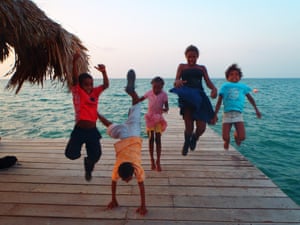 Children in the Islas del Rosario, Colombia Photograph: Margerita Zethelius
Children in the Islas del Rosario, Colombia Photograph: Margerita Zethelius
“In May 2014 the locals were recognised as legal owners of the land after a 10-year struggle,” says Margarita Zethelius, an environmentalist who works with the community.
During the legal struggle, the community looked at ways to become more sustainable. “They started getting in contact with eco villages and learning about permaculture,” says Zethelius.
With the help of NGOs the locals starting installing compost toilets and solar panels. Fundacion Surtigas installed panels for 34 families in 2007 and another five bought their own systems.
“The lack of light generates a lot of difficulties – for food storage, for the kids to study,” says Zethelius. “So more and more people have been buying solar panels, second-hand mainly.”
The mayor of the region, Cartagena, is supporting community calls for a centralised solar energy system. “If they had a system that would give energy to the whole community they could sell energy to the big hotels,” says Zethelius. “They wouldn’t be the poor ones, but would be selling services to the hotels. That would empower them.”
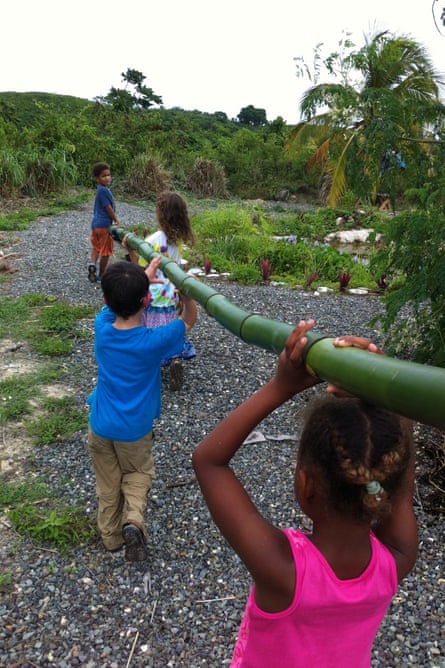 Children help out at The Source in Jamaica Photograph: Nicola Shirley-Phillips
Children help out at The Source in Jamaica Photograph: Nicola Shirley-Phillips
The Source, Jamaica
When her mother called for Nicola Shirley-Phillips and her siblings to move back from the US to Jamaica, she only reluctantly agreed. But now the extended family and friends happily live at The Source, a mini eco village with earth-bag homes and renewable energy.
The area, St Thomas Parish in the south east of the island, is economically impoverished and the family drew on the professional expertise learned in the US to contribute through healthcare, education and permaculture.
The family were the first in the parish to use solar energy. “Jamaica is very much a ‘show me’ place,” says Shirley-Phillips. “So people kept coming in our house to see how it worked, even professors. Then they were able to feel comfortable it. When we started there was only two solar companies in Jamaica and now the phonebook is full of them.”
The Source uses a combination of solar and wind for 70% of its energy. The rest is from the grid.
“We live on a hill so we can see when the rest of the parish has no power,” says Shirley-Phillips. “When there’s a hurricane people come to us to charge their phones.”
Hakoritna Farm, Palestine
In 2003 the Israelis built a wall right through Hakoritna Farm, an organic farm in Tulkarm, Palestine, taking 80% of the land. To add insult to injury, they built a chemical factory next door.
“We have tried to fight the destruction non-violently, without success,” says farm owner Fayez Taneeb. “However the core of the farm has endured in the middle of all this damage.”
Taneeb and his wife decided to make their farm a model of sustainability and peace. Students come to visit the farm to learn how to build biogas tanks that convert animal manure into energy and solar dryers to preserve fruit and vegetables. They can then set them up in their own villages and refugee camps.
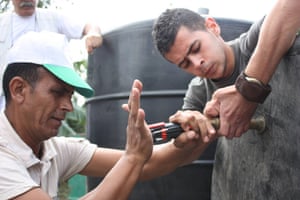 Building biogas equipment in Hakoritna Farm, Palestine. Photograph: Mena Vierra
Building biogas equipment in Hakoritna Farm, Palestine. Photograph: Mena Vierra
“By doing this we have created a movement of sustainable energy,” says Palestinian activist Aida Shibli. “It’s an extreme place. You see the contrast between dark and light.”
Sekem, Egypt
Ibrahim Abouleish’s friends thought he was crazy when he said he going to reclaim part of the desert north of Cairo for agriculture. But nearly 40 years laterSekem (named after the ancient Egyptian hieroglyph for “vitality”) is 2,800 hectares of green crops supplying successful textile, natural medicines and herbal tea businesses that employ 2,000 people.
This was all achieved using biodynamic agriculture techniques, a method of organic farming. Sekem’s approach is holistic, with an ethical code of conduct, schools from nursery right up to a university and a development foundation that runs microfinance projects and initiatives to help nearby farms convert to sustainable techniques.
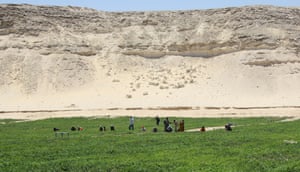 Green crops in the desert in Sekem, Egypt. Photograph: Sekem
Green crops in the desert in Sekem, Egypt. Photograph: Sekem
Sekem runs a couple of small renewable energy projects but gets most of its energy from the grid. “Unfortunately energy is so subsidised in Egypt that it’s not competitive,” says Thomas Abouleish, grandson-in-law of Ibrahim. But he says Sekem is preparing for the government’s plan to reduce the subsidies: “We recently started some renewable energy projects so they can be ready once people start to recognise that there is an alternative.”
These eco villages all feature in ECOVILLAGE: 1001 ways to heal the planet, edited by Kosha Joubert and Leila Dregger.